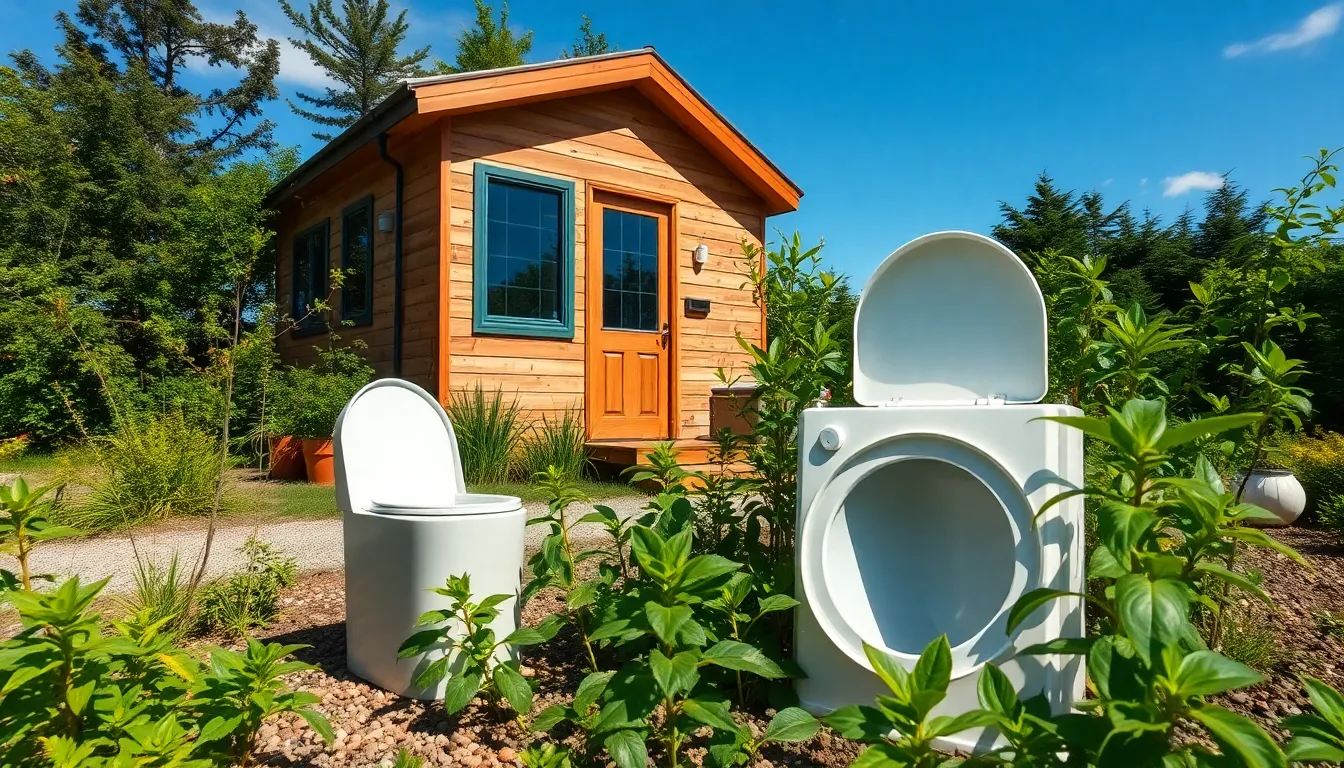Table of Contents
ToggleIn the world of tiny living, where every square foot counts, the last thing anyone wants to deal with is a septic system that’s bigger than their house. Imagine trying to fit a traditional septic tank into a space that’s already cozy enough for a cat to feel claustrophobic. Fear not, tiny home enthusiasts! There’s a way to manage waste without sacrificing your minimalist dreams or your backyard barbecue.
Overview of Tiny House Septic Systems
Tiny house septic systems offer innovative solutions for waste management in confined spaces. These systems often use smaller tanks compared to traditional setups, fitting seamlessly within limited areas. A common option involves composting toilets, which reduce water usage and require no septic tank. Another alternative features portable wastewater treatment systems, which process greywater effectively.
Many tiny home owners prefer mounded or sand filter systems that function well in areas with high water tables. These types maintain soil health while mitigating contamination risks. Some systems incorporate anaerobic bacteria that treat waste without electricity, allowing for energy efficiency.
Local regulations often dictate the specific system required for tiny houses. Researching these regulations ensures compliance and helps avoid legal issues. Choosing the right system enhances sustainability and reduces environmental impact.
Maintenance plays a crucial role in the longevity of septic systems, especially in tiny homes. Regular inspections and pumping, typically every three to five years, help prevent costly repairs. Educating users on waste disposal practices enhances the efficiency of operation and minimizes environmental concerns.
Tiny house septic systems demonstrate that eco-friendly living doesn’t compromise hygiene or functionality. With various options available, homeowners can select systems that align with their values and lifestyle. Understanding available alternatives empowers tiny home communities to make informed decisions about waste management.
Types of Tiny House Septic Systems
Tiny house owners can choose from several septic system types, tailored specifically for limited space and environmental impact. Each option offers unique benefits that align with a minimalist lifestyle.
Absorption Systems
Absorption systems excel in small spaces. They consist of a septic tank followed by a leach field where wastewater gradually filters into the soil. These systems promote natural decomposition, minimizing odors and maintaining soil health. Variations such as mound systems or gravity-fed systems adapt to specific site conditions. Many homeowners prefer these options due to their simplicity and effectiveness. They fit well into areas with high water tables or poor drainage. Regular maintenance ensures optimal performance, allowing tiny homes to integrate these systems without compromising space.
Alternative Treatment Systems
Alternative treatment systems offer advanced methods for managing wastewater. They include technologies such as aerated wastewater treatment and constructed wetlands. Aerobic treatment units employ oxygen to enhance decomposition, making them efficient for small spaces. Constructed wetlands mimic natural filtration, offering an eco-friendly approach to wastewater management. These systems often require less space than traditional septic tanks while providing effective treatment. Regulations vary by location, but many communities recognize their viability as sustainable solutions. Educating homeowners about proper usage helps maximize these systems’ benefits, ensuring both functionality and environmental protection.
Key Considerations for Tiny House Septic
Tiny house septic systems require careful planning to optimize space and meet functional needs. Selecting the right system and understanding local guidelines ensures effective waste management.
Space Requirements
Space constraints in tiny homes demand compact septic solutions. Small tanks and alternative systems fit well in limited areas. For instance, composting toilets save space by eliminating the need for a traditional tank. Mounded systems present another effective choice for compact builds, allowing for better drainage and soil absorption. Designers should also consider groundwater levels when planning installation. Understanding the specific layout of the tiny house helps in choosing the right septic option, aligning with both efficiency and minimalism.
Local Regulations
Adhering to local regulations significantly impacts septic system success. Most municipalities enforce specific guidelines regarding septic systems for tiny homes. Homeowners often need to secure permits before installation to avoid legal issues. Regulations can dictate system type, size, and design according to state laws. Consulting local health departments often provides clarity on these requirements. Additionally, abiding by regulations ensures environmentally friendly practices that contribute positively to community sanitation standards. Compliance with these rules protects both homeowners and the environment.
Maintenance Tips for Tiny House Septic Systems
Maintaining a tiny house septic system is vital for its efficiency and longevity. Regular attention keeps systems functioning properly and minimizes environmental impact.
Regular Inspections
Inspections solidify the health of septic systems. Scheduling them every one to two years allows homeowners to identify potential problems early. Professionals typically check for leaks, unusual odors, and solid waste build-up in the tank. Observing wastewater flow patterns further aids in detecting drainage issues. Maintaining a record of these inspections helps track system performance over time.
Common Issues and Solutions
Homeowners may encounter various issues with tiny house septic systems. Clogs might result from improper waste disposal, such as flushing non-biodegradable materials. To alleviate this, adhering to guidelines on waste management proves essential. Odors frequently arise from poor ventilation; adding vent pipes can help mitigate such problems. Soil saturation around the leach field may indicate a backup, necessitating an evaluation of the drain lines and tank. Addressing these common issues promptly ensures optimal system performance and compliance with local regulations.
Advantages of Tiny House Septic Systems
Tiny house septic systems offer significant benefits tailored for compact living. Space efficiency represents a crucial advantage, allowing homeowners to utilize small residential footprints without sacrificing sanitary needs. Environmental impact plays a vital role, as many of these systems are designed to minimize ecological footprints, promoting sustainable waste management.
Cost savings arise with these innovations. Smaller systems generally require less upfront investment and lower maintenance costs, enabling homeowners to allocate funds to other essential aspects of their minimalist lifestyle. Flexibility introduces another advantage, with various system types available to meet specific site conditions and homeowner preferences.
Local regulations often support the implementation of tiny house septic systems. Many municipalities encourage eco-friendly solutions, making it easier for owners to comply with legal guidelines while addressing waste management. Compliance further enhances property value, as homes equipped with efficient systems adhere to local standards, attracting potential buyers who value sustainability.
Health and safety considerations remain paramount, as efficient septic systems prevent contamination of groundwater. Regular maintenance ensures optimal performance, providing peace of mind for homeowners concerned about sanitation. Peace and tranquility accompany those who choose well-designed systems, allowing for the enjoyment of nature without the worry of waste disposal issues.
Ultimately, tiny house septic systems present a range of advantages that support both lifestyle and environmental goals. Homeowners enjoy the freedom of a minimalist lifestyle while ensuring hygienic waste management, thereby enhancing their overall living experience.
Conclusion
Tiny house septic systems offer a practical solution for homeowners looking to maintain a minimalist lifestyle while ensuring effective waste management. By exploring innovative options like composting toilets and alternative treatment systems, individuals can find the right fit for their unique living situations.
Regular maintenance and adherence to local regulations are crucial for optimal performance and longevity. With the right approach, tiny homeowners can enjoy the benefits of efficient septic systems that support both their lifestyle and environmental goals. Embracing these solutions not only enhances property value but also promotes a sustainable way of living.








